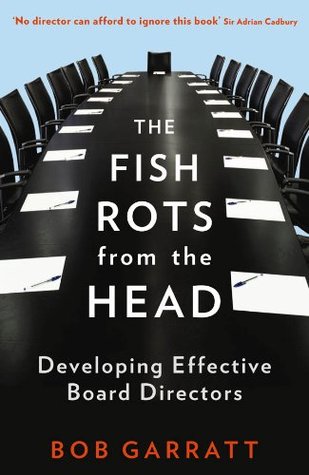More on this book
Kindle Notes & Highlights
by
Bob Garratt
Read between
February 12 - February 23, 2020
The job of the board is all to do with creating momentum, movement, improvement and direction. If the board is not taking the company purposefully into the future, who is?
A rule of thumb is that it will take around one day per week to fully carry out these directoral duties. This horrifies many directors, who have problems in finding the time to read the board papers and trying to make the monthly board meeting. The idea that they will have to do homework and other duties is simply unacceptable. Fine. But they should not then be on the board.
Direction-givers need a ‘brain-on’, rather than a hands-on attitude.
They need instead to see themselves as the centre of the enterprise – the cybernetic fulcrum, or central processor – monitoring and coping with the results of the external and internal learning processes of the whole enterprise.
The four directoral balances are: 1 Organizational effectiveness. The external, long-term perception in the customer’s mind of the products or services of the business being desirable, reliable and good value for money. 2 Organizational efficiency. The internal, short-term focus on cost reduction and efficiency gain – but only until just before it negatively affects the customer’s perception of organizational effectiveness. 3 Board performance. The external focus of the board on policy formulation in relation to the external political environments; and on strategic thinking about the
...more
A board is a living and watchful organism, not a clubby once-a-month meeting or a fixed battleground for representatives to hammer at each other.
Such yielding and groupthink under strong psychological pressure are a human phenomenon. A strong chairman will help resist this and bring out all the information and doubts needed to debate a proposal.
asking discerning questions is a key directoral skill, and the wish to ask them a necessary attitude.
Asking intelligently naive questions is what the directoral job is about, whether of the internal management and operational sys...
This highlight has been truncated due to consecutive passage length restrictions.
It is possible, indeed essential, to move a board from the usual management-crisis fixation via rigorous board and personal training and development processes to becoming a learning board – a board capable of positioning itself between the external and internal cycles of learning, and then integrating both.
Absolute power will corrupt, and without a diverse, questioning board the organization will collapse because of the individual’s own internal contradictions.
any three or more symptoms combined will cause collapse in the short to medium term: One-man rule A non-participating board An unbalanced top team A lack of management depth A weak finance function A combined chairman and chief executive role
Participation has two roots from its Latin base: joint ownership and joint responsibility.
Directors need to be happy constructively questioning and criticizing each other,
Independent directors are often more open to debate and participation, but can easily be excluded by the technobabble of the executive directors.
Unbalanced does not mean that the board is barking mad, although I have my doubts over some. It refers to the tendency to clone; to lack sufficient diversity to be able to think and debate at the policy-formulation and strategic-thinking levels.
The board must know enough about what is going on inside the organization and with customers to be answerable for its actions at law.
the capacity of the board to pose discerning questions to the operations people until they understand and are satisfied with their answers is a crucial board discipline.
The chairman’s job is to design and chair the process of the board’s meetings and subsequent activities. The chief executive’s role is to run the business.
eight key factors that block the use of sufficient diversity around the boardroom table and lead inevitably to the blocking out of any information that is contrary to the existing assumptions of the board: The illusion of invulnerability.
Collective efforts to rationalize. This is the condition where the board is faced with unusual, usually bad, information and rather than accept it pretends that it is either so unusual that it cannot be true, or that things often turn down around this time in the cycle and so avoids the issue.
Unquestioning belief in the board’s inherent morality.
Stereotyped views of rivals and enemies.
Direct pressure on dissident board members.
Self-censorship or deviation from apparent group consensus.
A shared illusion of unanimity.
The emergence of self-appointed ‘mind guards’.


